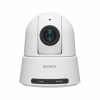Sony SRG-A40 Remote Camera System Guide - Page 11
Live Sports Events
 |
View all Sony SRG-A40 manuals
Add to My Manuals
Save this manual to your list of manuals |
Page 11 highlights
01010 Chapter 1: Application: Live Sports Events Live Sports Events Stadium Control room BRC-H900 BRBK-SF1 BRU-SF10 BRC-H900 BRBK-SF1 BRU-SF10 HXC-FB80 HXC-FB80 HXCU-FB80 HXCU-FB80 RM-IP10 Video switcher RCP-3100 RCP-3100 CCA-5 SDI Serial Fiber LAN Usage Shoot a sporting event for a sports program and record on a recorder at a remote site. PTZ cameras can be used as sub cameras to capture video from various locations, such as a position high in the stadium or near the player's bench on the field. User benefits ˎˎCeiling-mounted cameras can be used to shoot from high locations where camera operators cannot usually shoot. Combined with footage recorded by camera operators, this setup enables multi-location recording for realistic video. ˎˎCameras can be installed so that the view of spectators in the rear is not blocked when shooting the seating area or the stage from the front row of seats. ˎˎCombined with the optional fiber cable (BRC-H900 only) or a commercially available optical fiber converter, video can be transmitted over long distances from the stadium to a control room. ˎˎRemote camera control lets you capture player movements and spectator reactions without missing a thing. ˎˎProgressive signal format output from an HXC-FB80, operated by a camera operator, supports smoother video images during live broadcasts. ˎˎSupports HD HDR shooting to capture footage which is close to what the human eye captures in locations where there is a big difference in lighting between bright and dark areas, such as in a sports stadium. Setup and basic settings See below for information on connection and basic settings of devices shown in the system configuration example on the left. : Fiber extension from BRC-H900 (page 27) See the operation manual of each device for connection information not mentioned above.















